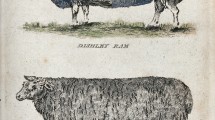Abstract
Darwin begins his “one long argument” not in the natural world of the deep past but – surprisingly and, for some readers, disappointingly – on the present-day world of the farm, providing a detailed look at domesticated plants and animals as well as the humans who breed them. Darwin’s opening chapter divides roughly into two halves. In the first half, Darwin surveys the amazing variability of plants and animals under domestication and some of the main causes of that variability. In the second half, he turns from variation to selection: the picking for breeding of the individual dogs or pigeons or cabbages or whatever which are the fastest or the strongest or the most colorful or the tastiest or whatever, in the hopes that those attractive variations will be inherited by offspring. It is mainly through selection of inheritable variation, Darwin argues, that humans have created so many and such diverse domesticated varieties of plants and animals, suited so splendidly to human needs and desires. A large part of being able to follow Darwin’s reasoning through the densely fact-packed paragraphs in this chapter lies with seeing where, in his view, it’s all going: namely, the laying down of the foundations for an analogical argument linking the selective breeding-into-being by humans of new varieties, or “artificial selection,” with a comparable process in nature capable of producing not merely new varieties but new species – what he will call, to flag the analogy, “natural selection.” It also helps to be alert to a number of ideas that Darwin held but which modern biologists reject, such as the notion that domestication itself induces animals and plants to become far more variable than they are in the wild, and the idea that characters acquired in the course of an individual’s lifetime can be inherited (so-called “Lamarckian inheritance”).
Access this chapter
Tax calculation will be finalised at checkout
Purchases are for personal use only
Similar content being viewed by others
Notes
- 1.
On the “uniformitarian” scientific ideal expressed in Darwin’s ordering of the Origin, and how it can lead to disappointment for new readers – “they expect fanfare, and they get fantails,” as Stephen Jay Gould quipped – see Gould (2002, p. 105).
- 2.
The most extensive historical and philosophical analysis of the analogical argument to date is in White et al. (2021).
- 3.
On the long-run history of Lamarckian inheritance, see Gissis and Jablonka (2011).
- 4.
On the distinctively English emphasis on the good design of organisms and Darwin’s role in perpetuating it, see Radick (2009, pp. 155–8).
References
Darwin, C. (1859). On the origin of species by means of natural selection, or the preservation of favoured races in the struggle for life. John Murray.
Desmond, A., & Moore, J. (2009). Darwin’s sacred cause: Race, slavery and the quest for human origins. Penguin.
Gissis, S. B., & Jablonka, E. (Eds.). (2011). Transformations of Lamarckism: From subtle fluids to molecular biology. MIT Press.
Gould, S. J. (2002). The structure of evolutionary theory. Belknap Press.
Olby, R. (2013). Darwin and heredity. In M. Ruse (Ed.), The Cambridge encyclopedia of Darwin and evolutionary thought (pp. 116–123). Cambridge University Press.
Radick, G. (2008). Race and language in the Darwinian tradition (and what Darwin’s language-species parallels have to do with it). Studies in History and Philosophy of Biological and Biomedical Sciences, 39, 359–370.
Radick, G. (2009). Is the theory of natural selection independent of its history? In J. Hodge & G. Radick (Eds.), The Cambridge companion to Darwin (2nd ed., pp. 147–172). Cambridge University Press.
Radick, G. (2010). Did Darwin change his mind about the Fuegians? Endeavour, 34, 51–54.
Radick, G. (2018). How and why Darwin got emotional about race. In E. Sera-Shriar (Ed.), Historicizing humans: Deep time, evolution, and race in nineteenth-century British sciences (pp. 138–171). University of Pittsburgh Press.
White, R. M., Hodge, M. J. S., & Radick, G. (2021). Darwin’s argument by analogy: From artificial to natural selection. Cambridge University Press.
Author information
Authors and Affiliations
Corresponding author
Editor information
Editors and Affiliations
Rights and permissions
Copyright information
© 2023 The Author(s), under exclusive license to Springer Nature Switzerland AG
About this chapter
Cite this chapter
Radick, G. (2023). Origin’s Chapter I: How Breeders Work Their Magic. In: Elice Brzezinski Prestes, M. (eds) Understanding Evolution in Darwin's "Origin". History, Philosophy and Theory of the Life Sciences, vol 34. Springer, Cham. https://doi.org/10.1007/978-3-031-40165-7_12
Download citation
DOI: https://doi.org/10.1007/978-3-031-40165-7_12
Published:
Publisher Name: Springer, Cham
Print ISBN: 978-3-031-40164-0
Online ISBN: 978-3-031-40165-7
eBook Packages: HistoryHistory (R0)




